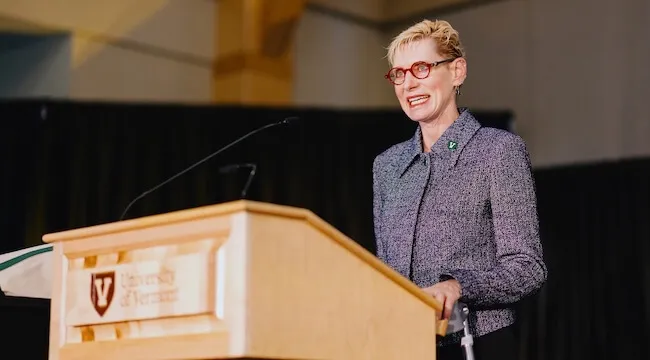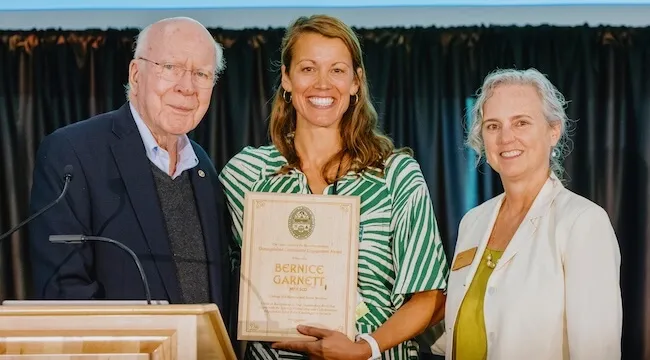An overflow crowd of attendees at UVM’s 2025 RISE Summit in UVM’s Davis Center on Tuesday, June 17, explored a range of university and community connections that highlighted the impact of university research, the need to build even more robust community participation, and the ever-important role communication plays in building public trust and support.
This was the third annual RISE (which stands for “Research, Innovation, Sustainability, and Entrepreneurship) Summit presented by UVM’s Leahy Institute for Rural Partnerships. More than 800 attendees, in person and online, gathered for a day-long slate of interactive events featuring UVM scientists, researchers, technical experts and community leaders from across the fields of education, health care, public administration, local businesses, public utilities, social services, and the arts.
“We believe that research is a key ingredient for solving problems, and when done in intentional partnership with towns, businesses, agencies, farms, schools, and entrepreneurs, the impact is multiplied,” said Leahy Institute Director Patricia Coates in her opening remarks.
That sentiment was echoed and amplified by UVM President Designate Marlene Tromp in her welcoming remarks, in which she referenced Vermont Senator Justin Morrill’s namesake legislative act that established the public land-grant university model in 1862.

“We've come to recognize that, in order for institutions like universities to serve, we can't just expect people to come to us,” Tromp said. “We must reach out to them, we must travel to them, we must connect with them, and we must ask them what they need… the power of the Land-Grant Act is a power of people, projects, and connections.”
The RISE keynote address was given by Dr. Mark Becker, president of the Association of Public and Land-Grant Universities (APLU), the research, policy, and advocacy organization that represents public institutions of higher education throughout North America. Becker acknowledged the high degree of uncertainty around university research fueled by recent federal actions and, with that in mind, examined the current state of public trust and confidence in higher education (particularly higher education’s scientists), the historical and current role of land-grant institutions such as UVM, the need for what he termed “public impact research,” and better communication of those efforts.
“University research has been fundamental to the U.S. economic prosperity and national security,” Becker said. “Public research universities in America exist for a public purpose, not as just towers of science and knowledge but as a place where people get a real and practical education to improve society, to improve lives for others.”
RISE attendees followed three topic tracks through breakout panel discussion sessions at the summit. The “Asking the Right Questions” track explored community-based participatory research as a path forward at a time when public trust in institutions and science has eroded. The process is highly inclusive of the public in both defining and solving problems from the outset.
“I like to say that community-based participatory research is basically doing research for people, with people,” explained panel discussion member Ernesto Mendez, professor of agroecology and co-director of UVM’s Institute for Agroecology.

Building teams and partnerships was the focus of another subject track. Dan Kopin, manager of innovation at Vermont Electric Power Company (VELCO) pointed to an ongoing VELCO-UVM cooperative project to better understand strains on Vermont’s electric grid as an example of the benefits university expertise can bring when an effective team structure allows for efficient gathering and sharing of data.
Communicating the effects of research was the subject of a third track. In a lively panel discussion, moderator Susan Evans McClure, from the Vermont Arts Council, noted that lots of great research happens at UVM and other institutions in Vermont. But she also pointed out that if all this takes place without effective communication, does it really garner the public impact it deserves?
Three panelists—Christopher Kojzar, an artist in UVM’s College of Arts and Science, Ben Cooley at UVM’s Complex Systems and Community News Centers, and Karen Anderson from Vermont Public—provided diverse and powerful case study examples of effective outreach to broad audiences.
Over lunch and learn sessions, summit participants engaged with experts from local government and the university and discussed topics from housing to school/health care partnerships to the work of innovation hubs and co-working spaces across the state.
Afternoon sessions included presentations from four teams of UVM students associated with UVM’s Academic Research Commercialization program (ARC). In short, three-minute presentations these student entrepreneurs detailed their projects dealing with harmful algal bloom detection, farm animal wound dressing, machine-speech programs to assist ALS patients, and tools for caregivers navigating emotionally loaded moments with young patients.

The Leahy Center’s namesake, former Senator Patrick Leahy, then presented the second annual Leahy Institute Award for Distinguished Community Engagement to Bernice Garnett, the Burack Family Green and Gold Associate Professor in UVM’s College of Education and Social Services and the principal investigator of the Catamount Community School Collaborative, a research, policy, and practice partnership with the Vermont Agency of Education and community school partners that is dedicated to community school implementation and sustainability in Vermont..
“Bernice and her team are supporting the rich connection between schools and communities to build a learning environment that's good for staff, teachers, and students alike,” Leahy said.
An afternoon keynote panel further explored the concept of research as a public good. Panel member Kirk Dombrowski, UVM’s vice president for research and economic development, noted a unique and valuable attribute of university research – the ability to explore open-ended research that often leads to unexpected dividends.
“I don't think there’s another institution in the world other than higher education that has the capacity to spend open-ended discovery time and resources the way that we do,” Dombrowski said. “We play a role that no one else can play.”
Coates announced the opening of the third round of Leahy Institute partnership grants at the summit. These grants fund research projects that are responsive to community needs and reflect the collaboration of researchers with partners on the ground.
In closing remarks, Coates noted that “there are a few takeaways for the Leahy Institute and for the rest of us here at UVM, and number one is to really look at the incentives that we might provide for our faculty, staff, and students to engage in the community. Number two is to always hold the community need as our north star. And number three is to just keep doing the best that we possibly can.”
======================
Mark Becker's RISE keynote address can be viewed here.
